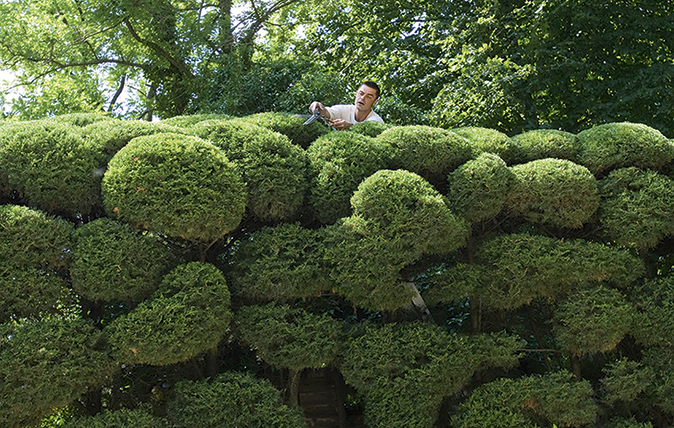The art of the tree surgeon
Tree surgeons are such skilled people


The tree surgeon has completed his winter visit and I gaze with admiration on a 20ft-high dome of sweet bay (Laurus nobilis), whose freshly clipped outline has all the perfection of a piece of architecture by Wren or Soane (I do not exaggerate its perfection).
Our 20ft-high Leyland cypress hedge, which passes for yew from a distance, was planted by the previous owners of the house, to obscure the view of the neighbouring farm silos. These disappeared 20 years or more ago, but the hedge now serves as a barrier between us and the three detached houses that replaced the agricultural storage vessels.
Our surgeon, Gavin, uses a long-arm, petrol-driven hedge clipper to trim its sides. To trim the top, he walks along the hedge as any of us would do along a tarmac footpath as if it were smooth and flat and even, which, thanks to his annual ministrations, I suppose it is.
This makes the point that, if Leyland cypress (x Cupresso-cyparis leylandii) is regularly clipped (but not so far back as to reveal its brown stems, which will never regenerate green growth), it makes a superb hedge. I once encountered a retired gardener on the island of Jersey who clipped his leylandii hedge by hand once a month it had the smoothness of concrete render. Lacking the inclination to follow suit, we still manage to have an evergreen hedge that is every bit as dense as yew.
Speaking of which, two years ago, Gavin reduced the canopy of a massive yew in the centre of the garden, cutting it back by about 10ft. The result was an even dome of branches, but the ends were freshly cut and raw. I knew the immediate effect wouldn’t be handsome, but I also had confidence in the regenerative capacity of yew. Cut it back as hard as you like and it will sprout from branches as thick as your thigh.
My confidence wasn’t misplaced. Two years on, the cuts are invisible, having been masked by a dense mist of new shoots. Result? An invigorated tree that casts far less shade. It’s now some five years since I planted a double avenue of horn-beams behind the barn. I didn’t want to pleach them, as that treatment would mask the lateral view across the wildflower meadow in one direction and a wildlife pond in the other. Instead, I wanted them cut into boxy shapes on top of a 3ft-high clear stem, so that they made a double-cube shape 6ft high by 3ft wide and deep.
I will come clean and confess that the shape was copied from photographs I saw in Country Life of hornbeams in the garden of Anouska Hempel. My hornbeams are now at the mercy of Gavin, and, five years on, they have just about fulfilled their desired size and shape, but will, thanks to his annual visit when they’re dormant, continue to thicken up their ‘double cubes’ over the next few years.
Sign up for the Country Life Newsletter
Exquisite houses, the beauty of Nature, and how to get the most from your life, straight to your inbox.
Strange stirrings
The unseasonable December weather had strange results. Two branches on Viburnum tomentosum var. plicatum have been in flower for several weeks now. I don’t think this will affect its spring flowering, as, elsewhere, the tiny buds of the normal season’s flowering are just visible.
Some daffodils are also blooming earlier than usual, but I see no point in running around like a chicken with its head cut off. With colder, more seasonal, weather, they will simply slip into suspended animation and catch up with themselves later on. It’s the late frosts in April and May that do the most damage, burning fruit-tree blossom, causing complete crop failure.
Normally, by this time, I’ve chopped off all of last year’s foliage on my Lenten hellebore (Helleborus x hybridus), but it’s remained so healthy and unsullied by weather this year that I’m late off the mark. Now, it’s a matter of snipping off all the leaves at ground level, trying my best not to damage the flower stalks that have already started to push up and open their flowers among them. They’re useless as cut flowers, wilting instantly, so we float the blooms like water lilies in a bowl on the kitchen table a reminder that spring isn’t far away.
Country Life is unlike any other magazine: the only glossy weekly on the newsstand and the only magazine that has been guest-edited by HRH The King not once, but twice. It is a celebration of modern rural life and all its diverse joys and pleasures — that was first published in Queen Victoria's Diamond Jubilee year. Our eclectic mixture of witty and informative content — from the most up-to-date property news and commentary and a coveted glimpse inside some of the UK's best houses and gardens, to gardening, the arts and interior design, written by experts in their field — still cannot be found in print or online, anywhere else.
-
 Vertigo at Victoria Falls, a sunset surrounded by lions and swimming in the Nile: A journey from Cape Town to Cairo
Vertigo at Victoria Falls, a sunset surrounded by lions and swimming in the Nile: A journey from Cape Town to CairoWhy do we travel and who inspires us to do so? Chris Wallace went in search of answers on his own epic journey the length of Africa.
By Christopher Wallace
-
 A gorgeous Scottish cottage with contemporary interiors on the bonny banks of the River Tay
A gorgeous Scottish cottage with contemporary interiors on the bonny banks of the River TayCarnliath on the edge of Strathtay is a delightful family home set in sensational scenery.
By James Fisher